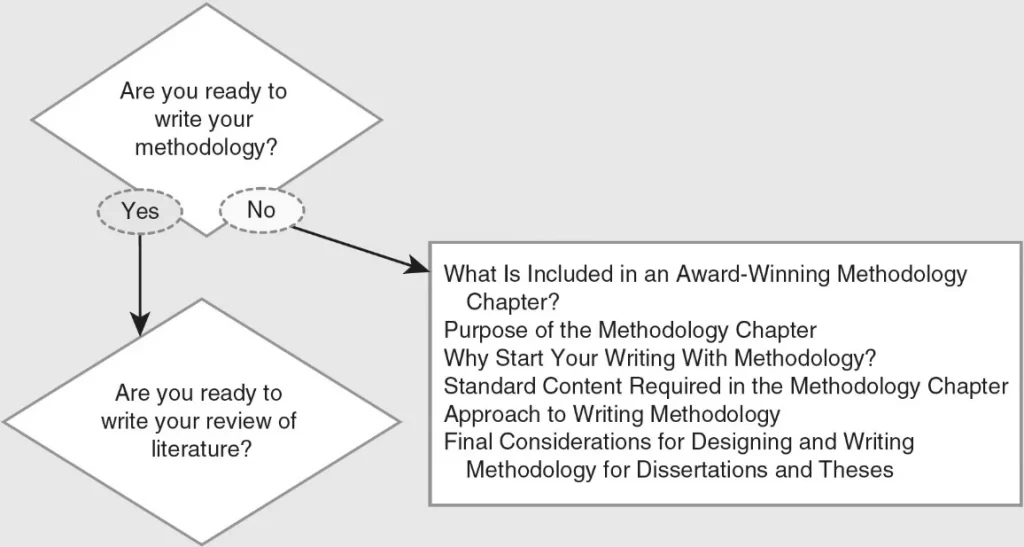Tips to Write Dissertation Methodology
Published by at August 12th, 2021 , Revised On September 20, 2023
Methodology section of a dissertation typically deals with how you conducted your study. What methods did you use (quantitative/qualitative)? What data collection instrument did you use and why? Who were your participants? How did you sample from your population of interest?
…and so on.
You have conducted your research. Now it’s time to ‘tell the story’ to your readers as to how you did that. Methodology is where you tell that story.
And like any good story, this story, too, must be intriguing; mindful to your readers about why you conducted the study, to begin with; talks about the possible pitfalls you may have faced in your data collection process (limitations, reliability and/or validity issues, etc.)
A few useful tips here and there about how to tell this story well might be just what you need right now. So, let’s dive right into it and look at some tips for you to write an amazing dissertation methodology.
Tips to Write a Good Dissertation Methodology
These steps are essential to write a good dissertation methodology
- Remind your Readers of the Research Problem
- Be Clear from the Start About the Approach
- Reproducibility and Reliability
- Precedence
- Justify your Methodology Well
- Be Logical About your Justifications
- Make it Reliable and Valid
- Sampling
- Include an Appendix
Tip #1: Remind your Readers of the Research Problem – Why you did & what you did
You must have written a literature review before the dissertation methodology section. It focuses on the research questions and enables you to explore the problem, which will be addressed in the dissertation.
Start off your methodology chapter by reminding the reader what that research problem was, so they know that what’s to come in the remainder of the question was all done, on your part, to try to solve that initial problem, or to answer some perplexing research question you started off with.
Don’t just start telling the story. Warm up your readers first. Pick at their interest!
Tip #2: Be Clear from the Start About the Approach you Took in your Methods
What type of methods did you use in your research and why? How did you collect the data? Did you use any software, such as SPSS, to analyse your results?
You are required to provide a sketch of the approach you will be using in the dissertation methodology. It will include all the methods you are going to opt for in the dissertation methodology section. You should mention what conclusion you are expecting from the chosen methodology.
Think of this step as the part in the story-telling process where you introduce your listeners (in this case, your readers) to the main characters of your story, what their roles will be, etc.
Interesting watch: Find out how to write the methodology section of a dissertation in 4 easy steps!
Tip #3: Reproducibility and Reliability
Explain your design methodology so that it becomes possible for others to work on it (replicate it) by considering your own budgetary and time limits. Honesty goes a long way here. for instance, if you tell your readers about how you couldn’t get a set of responses from a certain institution, it might help future researchers go better prepared to such a setting.
Try not to be stiff in discussing your methodology approach; however, mention the steps you took in your methodology in a flexible manner, so that if anyone wants to critique your work, they can do so without any difficulty.
This is perhaps one of the most useful tips you will ever need for creating a well-crafted methodology chapter. For in research, critiquing others’ work paves way for future research and adds to the existing body of knowledge, one of the most sacred goals of all research anyway.
Does your Research Methodology Have the Following?
- Great Research/Sources
- Perfect Language
- Accurate Sources
If not, we can help. Our panel of experts makes sure to keep the 3 pillars of Research Methodology strong.

Tip #4: Precedence
Did you come up with your own methodology to collect and analyse data? Did you adopt or adapt an existing one? If you built on an existing methodology—such as a specific self-esteem scale you used to measure respondents’ self-esteem through a questionnaire—mention that in all honesty.
Are there any reliability and/or validity issues with that existing methodology? Mention those to your readers, too.
All in all, take precedence of the fact that what you have done in your data collection and methodology step might have been done by someone else out there, before you. Give them due credit. Describe all the things you did differently in your methods from that used by others’.
Remember: Your methodology section should include information about 4 key elements: the research design; data collection tool(s); participants; procedure(s).
Tip #5: Justify your Methodology Well
Always back your methodology with justification. Tell your audience the reasons why you chose this methodology for your research and why another one wasn’t suitable enough for you. While preparing the dissertation methodology, keep in mind that the more unorthodox your methodology is, the stronger its justification.
Tip #6: Be Logical About your Justifications
Everything has to be backed up with accurate, logical arguments in research. The methodology section is no different. While writing it, elaborate to your readers what your logic is—not another researcher’s or writers, but solely YOURS—behind using method A over method B.
Or how sampling technique B would not have helped you as much as sampling technique T did (hypothetical labels here, of course).
Make sure you investigate and mention alternative options to logically claim that what you did and how did is more relevant enough than what others have done for the same research area. This logic will warm up your readers towards your justification for your results (later in findings chapter).
Tip #7: Make it Reliable and Valid
One of the tips to write dissertation methodology flawlessly is to make sure you don’t cling to a methodology that can raise questions about your research’s reliability and validity. Make this section precise, accurate, free from errors and provide statistical details where required.
Tip # 8: Sampling
When choosing sampling techniques, one should select a sample population aligned with the methodology to be used, as different sampling methods are used for different types of research.
Be as accurate and dominant about your stance regarding your choice of sample and sampling technique as possible. Why? Because, among other reasons, the finding(s) you conclude from your research will ultimately be generalised back to your research population.
Assuming that you did everything right by this point—identified your population of interest, sampled from that population with minimal sampling error and so on—your results would be a whole lot easier to generalise back to your population if you used the appropriate sampling technique, to begin with.
For instance, if you used snowball sampling (used when the target population is difficult to identify and get to) technique but generalise your results to a population that’s so common (isn’t hard to get to, that is), it will totally negate your reason for using snowball sampling, to begin with.
Tip #9: Include an Appendix
The methodology section cannot be completed without including the appendix to provide relevant data, i.e., questionnaires, responses, or any outliers to be mentioned.
Since you will be mentioning and/or referring to certain elements of your data collection tool (such as question item number 4 dealt with…) at least a few times in your methodology section, it’s important to provide that source (the tool) within an appendix. This thereby creates the need for an appendix that readers can refer to while reading your methodology.
Example of a well-written Methodology Section with Aforementioned Tips
Check out this sample of a methodology chapter, which contains some of the key points mentioned in this article. Just skip right over to the section labelled ‘Research strategy’.
To Conclude…
Methodology section of a dissertation contains information about how the research was carried out. It describes everything—from sampling techniques and data collection tools to the participant and procedural information—that was done to collect data. It’s the part where you tell the story of how you did what you did.
It’s important, therefore, to tell the story honestly. Be clear, precise, accurate and logically justify all your reasons for choosing one methodological approach over another; one sampling technique over another. Make it clear whether you came up with your own data collection methods or adopted existing ones.
Include things like questionnaires in an appendix that will be related to the methodology section alone. Make sure to explain how your methodology choices are reliable, valid and are generalisable from the sample to the population.
Are you depressed while trying to increase your school, college, or university grade point average, and you can’t get ahead? Our dissertation experts can help you with all aspects of your dissertation paper. Whether you need help with individual chapters or the whole dissertation paper, we can help you achieve the desired grade.
FAQs About Tips to Write a Dissertation Methodology
Justifications included for each step taken during the data collection procedure is vital to make a methodology chapter good. It should also relate back to the research problem; why you did what you did and how.
It should include 4 key elements: the research design; data collection tool(s); participants; procedure(s).
Ideally, that depends on the overall word count your institution/department provided you with; the nature of your research topic, etc. However, it’s standard to keep the methodology section stick to a 1,500 to 2,000 wordcount limit.
This is a very crucial part of writing this chapter. Without giving your readers a proper rationale behind your methodological preferences, your research won’t sound credible enough. Justify, logically, every course of action you took or didn’t take; why it was needed; why you didn’t opt for a certain technique, etc.







